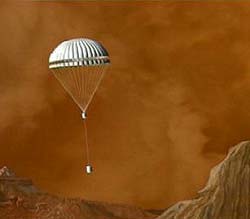This area deals with the fundamental laws and building blocks of nature and how they interact, the properties and the behavior of matter, and research into space and time and their structures.
innovations-report provides in-depth reports and articles on subjects such as astrophysics, laser technologies, nuclear, quantum, particle and solid-state physics, nanotechnologies, planetary research and findings (Mars, Venus) and developments related to the Hubble Telescope.

Zum letzten Mal fand dieses Naturschauspiel 1882 statt und erst im Jahr 2247 wird es wieder von Deutschland aus in voller Länge zu beobachten sein: der Venustransit. Am 8. Juni 2004 besteht nun die einmalige Chance von Jena aus zu betrachten, wie der innere Nachbarplanet der Erde vor der Sonnenscheibe herzieht. Dieses Spektakel ist so ungewöhnlich, weil die Himmelskörper selten in der dafür notwendigen Achse stehen. Der kommende Transit dauert von 7.20 bis 13.23 Uhr mitteleuropäischer Sommerzeit.

Location: Solar System
On June 8 Venus – the Earth’s sister planet – will pass in front of the Sun. This event, a ’transit’, is extremely rare – the last one occurred in 1882, 122 years ago. Easily observable in Europe, Asia, Africa and Australia, it is likely to attract the attention of millions of people on these continents and, indeed, all over the world.
On this important occasion, the European Southern Observatory (ESO)has joined forces with the European

After a 7-year, 2.2-billion-mile looping voyage across the solar system, the international Cassini mission reaches Saturn on June 30 Cassini promises to run rings around earlier spacecraft-Saturn encounters. One of the biggest planetary spacecraft ever built, Cassini won’t just fly by Saturn. It will be the first spacecraft to orbit Saturn, sending data from 12 orbiter experiments back for at least the next four years. In December, Cassini will launch a European-built probe calle

By exploiting the weird quantum behavior of atoms, physicists at the Commerce Department’s National Institute of Standards and Technology (NIST) have demonstrated a new technique that someday could be used to save weeks of measurements needed to operate ultraprecise atomic clocks. The technique also could be used to improve the precision of other measurement processes such as spectroscopy.
The technique, described in today’s issue of Science, effectively turns atoms into better frequency s

When ESA’s Huygens spaceprobe, travelling on board NASA’s Cassini spacecraft en route to Saturn, lands on the planet’s largest moon Titan in January 2005, not only will it carry a variety of scientific instruments, but also music ‘made in Europe’.
Four musical themes composed by French musicians Julien Civange and Louis Haéri were placed on board ESA’s Huygens probe in October 1997. After a seven-year and 4000 million kilometre journey, the music will reach Titan on 14 January 200

Tomorrow, on June 8, beginning shortly after 5 hrs UT, a large part of the world will be sharing a unique sight never seen by any person now living. During a little more than six hours, planet Venus will cross the face of the Sun, offering a wonderful show for everybody to admire. Nobody should miss the opportunity to witness this great event! And – good luck! – it appears that the observing condition prospects are rather favourable in large areas of the world.
Nevertheless, should you be as